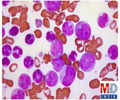New study findings about the genetics of mixed phenotype acute leukemia (MPAL), a type of cancer with features of both acute myeloid leukemia (AML) and acute lymphoblastic leukemia (ALL) have been reported.

‘New study findings set the stage for research into better treatment of this rare and high-risk blood cancer that accounts for approximately 3 percent of childhood acute leukemia cases in the United States.’





"Before now, no one has comprehensively studied the biology of this cancer. We were able to compile a large group of samples to characterize the genetics in these high-risk cases with features of both acute myeloid and acute lymphoblastic leukemia," said Alexander, who is an assistant professor in the UNC School of Medicine Division of Pediatric Hematology-Oncology, and was formerly a clinical fellow at St. Jude. Studies report a range of survival rates between 47 and 75 percent for children with mixed phenotype acute leukemia, which also occurs in adults. There is no consensus on the best way to treat the disease.
"ALL and AML have very different treatments. But MPAL has features of both, so the question of how best to treat patients with MPAL has been challenging the leukemia community worldwide--and long-term survival of patients has been poor," Mullighan said.
Since the disease is rare, researchers worked with collaborators from around the world to gather samples from 115 cases to comprehensively study the biology of the disease. They analyzed the DNA and other genetic features to better understand how the disease evolved, and to reveal treatment insights.
They found the phenotypic subtypes of this disease had different genetic features that could have treatment implications. The T/myeloid subtype shared similarities with early T-cell precursor ALL, a finding that could inform the best treatment approach. The B/myeloid subtype often had a change in the ZNF384 gene that is also found in B-cell acute lymphoblastic leukemia, leading researchers to believe that ALL treatment may be the best approach initially.
Advertisement
The researchers also discovered that within individual cases, the lymphoid and myeloid components of these tumors contain the same genetic alterations, suggesting that the mutations arose early and before the blood cells had matured into distinct types. This finding may help explain how the cancer evolves.
Advertisement
The researchers say the next step is to determine if the laboratory insights can translate into improving clinical outcome for patients with mixed phenotype acute leukemia.
"On this basis of this data and other recent publications, the Children's Oncology Group is in the final stage of planning a protocol that will enroll patients with mixed phenotype leukemia on a prospective trial for the first time ever," Alexander said.
Source-Eurekalert















